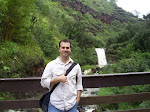

The past few weeks have flown by. Two major holidays and the kids getting out of school for a 6-week break tends to do this. The kids got out of school about two weeks into December and the University shut down on the 18th. However, with my professor's help, I was able to submit my final PhD research plan for confirmation of enrolment with the University. I had a goal to get this accomplished well before my 6 month time window expired at the end of January. In reality, I wanted to have this accomplished by mid-November but it did not work out this way. I have received ethical approval for the research, and this was done by November. My delay was my own- I was reading more material and wanting to make sure my additions and refinements to the proposal were accurate and informed. I believe I accomplished my aim in this regard.
Before my son's school let out, they did have one last field trip, for which I volunteered to again chaperon. Several classes from the elementary school took a trip up to a nearby hill/mountain/reserve called Maungakawa or Sanitarium Hill, outside Cambridge (NZ of course). The site had in times past, especially spanning the World Wars, been a rest hospital for war-wounded and before that a sanitarium for sufferers of tuberculosis. Before this it was a family's estate, built by a wife whose husband died with dreams of a mansion unrealised.
The site is quite prevalent in the region and is forested to some degree. It now is a reserve and park with hiking/tramping trails and open picnic areas. Only an old small stone decrepit building remains to attest to its former use. The reserve now seems to be aimed at maintaining and preserving what native foliage and animal life there exists. The blood thinner poison 1080 is dropped there to control pest populations. There is no pest-proof fence there as there is at Maungatautari- and of course it it minuscule in comparison anyway so there is little to preserve relatively. However, any portion can make a difference, hence the reserve status.
The trails at Maungakawa are not metalled (gravelled) like Maungatautari, and so they are muddy and slippery. Many of us slipped a bit at times- not falling, but just loosing footing. The school kids and leaders went on a short trail/track, ate lunch and played some games there. Most of the adults sat under a large tree in a field to eat lunch and talk. As an aside, in the thank you card the school kids later gave me, they suggested that in the future, I should play the games (including Cricket) with them. Perhaps I will do just that next time. However, it is important that I get to know as many people here in Cambridge as possible. One can never have too many friends and in terms of research this also applies. A few of us had a good open conversation, talking about where we grew up, how we came to be here in NZ. From these and other conversations, new articles, and news reports, there is a fair amount of relocating back and forth between OZ (Australia) and New Zealand. One family had come to NZ from the UK- Scotland to be precise- and then moved to OZ, and then back to NZ.
December at this point is nearly over. It has come and gone. Christmas was good, with good neighbors who gave gifts to my children and invited us to lake Karapiro down the road on Christmas day, many good people we have been able to visit/carol and those who visited us. Just the other day, my supervisory professor came over to my neck of the woods and brought his family for a visit to Maungatautari. The jaunt up there came to be on a humid overcast day with no breeze. It was very uncomfortable in the morning, but later things cooled down a bit- at least on the mountain. We arrived and hiked far enough in time to see a feeding for the birds at the aviary on mountain. Rata blooms were visible from the tower and free-flying birds were easily seen, including Kaka, and stitchbirds among others. The bird calls in the forest were mesmerising and prolific. The group returned back to my home, despite a less than fun incident of my doing- as I missed the correct turn off- to a fabulous lunch graciously prepared by my wife, Amanda. We were all treated to her gourmet pizzas, salad, bruchetta, and for desert, homemade pumpkin pies and chocolate lava cakes. It was good to talk with good people and eat good food.
Well, Christmas vacation is nearly over, and back to work for me. This January I should start volunteer work on the mount and some Maori te reo and tikanga (language and custom) classes here in the community. Plus, I now have to gear up, outfit myself, and begin the real fieldwork. The pieces are nearly in place. I need to formally connect/commence with the Trust and area Hapu (subtribes) as ethical approval has been received and final full enrolment all but official, and I need to finish applications for additional funding from various sources including National Geographic. Lastly, I need to begin augmenting connections to people. All part of a happy new year!










